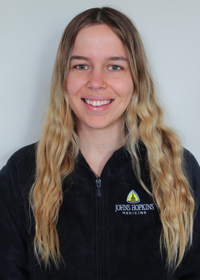Session Moderator: Eric Markvicka, University of Nebraska–Lincoln
Presentations in this session were chosen from the peer-reviewed contributed papers. The papers will be published in the 2023 Proceedings of the Design of Medical Devices Conference in the ASME Digital Collection.
Presentations are added as they are confirmed.
Expediting Esophageal Manometry through Creation of a Sleeve for a Nasogastric Tube

Sindhura Sridhar
Texas A&M School of Engineering Medicine
Abstract: Acute Respiratory Distress Syndrome (ARDS) is an acute inflammatory condition that causes impaired oxygenation and often leads to mechanical ventilation. Positive End-Expiratory Pressure (PEEP) is an extrinsic pressure applied during ventilation to maintain alveolar opening. Esophageal manometry is a useful tool in titrating PEEP to ensure adequate ventilation is being provided in cases of increased chest wall pressure. However, few pulmonologists or critical care specialists utilize esophageal manometry routinely because of the additional time, limited training opportunities, and esoteric calculations required to perform the procedure and evaluate the results. We have designed, prototyped, and tested a device to simplify and reduce the time necessary to perform esophageal balloon catheterization. This device contains a balloon sleeve that is placed over a standard nasogastric tube and is capable of measuring the esophageal pressure while ventilation is being provided. Based on the esophageal pressures, a web-based app created in tandem with the device calculates the desired PEEP for the ventilator settings to ensure adequate oxygenation of the patient. Experimental testing and statistical analysis showed that our prototype was able to measure pressure comparably to a current device on the market.
Bio: Sindhura Sridhar received her B.S. in Biomedical Engineering from the University of Texas at Austin in 2021. She is currently a second-year student pursuing her medical degree and master’s in engineering at the Texas A&M School of Engineering Medicine. Her research interests include acute respiratory distress syndrome (ARDS) and improving mechanical ventilation.
Co-Authors: Hunter Mansfield, Jason Shenoi and Sindhura Sridhar
Vestibular Implant Stimulation Pause Detection Thresholds: Implications for Design of Battery Depletion Alerts

Celia Fernandez Brillet
The Johns Hopkins University School of Medicine
Abstract: Vestibular implants (VI) modulate the rate and amplitude of charge-balanced current pulses to encode head angular velocity or acceleration. When the battery of a VI becomes depleted, stimulation interruptions can cause vertigo. To avoid this, VIs can use alert signals such as vibration and beeping to remind the user to replace the battery. However, in distracting and noisy environments typical of activities of daily life, some patients may fail to hear or feel those alerts, so a physiological signal can be used as an alternate channel for signaling battery depletion. Pauses in the stimulation waveform can be delivered for this purpose, with the length of the pause long enough to be detected reliably by the patient but not so long as to induce dizziness or a vertigo attack. As a guide for the design of a physiologic battery depletion alert system, this study reports the ability of nine long- term, continuous VI users to detect stimulation pauses of various durations. We also show the effect of distraction on patients’ detection thresholds and response latencies for detected events.
Bio: Celia is a PhD Candidate at Johns Hopkins University. Her main interest is the study of neural implants and interfaces for translational applications. Her PhD work focuses on studying the safety, efficacy, and potential improvements of the vestibular implant.
Co-Authors: Celia Fernandez Brillet, Margaret R. Chow, Andrianna I. Ayiotis and Charles C. Della Santina
Design of an MRI-Compatible Robot for Image-Guided Needle Insertion Procedures using Active Tendon-Driven Needles

Blayton Padasdao
University of Hawaii at Manoa
Abstract: Visualization and tip tracking of needles inside the body in needle-based interventions are usually challenging using conventional medical imaging modalities such as ultrasound and CT. MRI provides an amazing imaging feedback for the operator to target lesions with a great confidence. However, the needle should be operated teleoperatively using a robot interface. This work introduces a novel design of an MRI-compatible (slave) robot for image-guided needle insertions. The robot is designed with MRI-compatible materials and actuators to enable manual initial positioning inside the MRI bore prior to operation, as well as robotic teleoperation (insertion and actuation) of an active tendon-driven needle towards targets. The range of motion is shown to be appropriate for transperineal prostate interventions such as prostate biopsy and brachytherapy.
Bio: Blayton Padasdao received his B.S. degree from the Department of Mechanical Engineering at the University of Hawaii at Manoa in 2017. He received his M.S. degree in Mechanical Engineering in 2020 by utilizing shape memory alloys to investigate the material response in an active structure and is currently a Ph.D. student under Dr. Bardia Konh. His research is currently focused on working with medical robotics and improving ultrasound tracking for needle interventions especially for prostate brachytherapy/biopsy purposes.
Authors: Samuel Lafreniere, Olivia Lee Sprouse, Ryan Justin Padilla and Bardia Konh
Design Thinking to Prototype Development: Creating an Improved Healthcare Powered Air-purifying Respirator

Elizabeth Beam
UNMC College of Nursing
Abstract: An interprofessional team embarked on the design and prototyping of an improved powered air-purifying respirator for healthcare. They used 3D modeling to move their ideas from a list of key expectations to a virtual prototype. The design thinking concept of rapid prototyping and empathy interviewing ensured this design met the needs of the stakeholders who would use the product. Several significant changes in the design resulted from the rapid prototyping interviews. This process was enhanced by using a virtual reality software to allow the team to “see” the product and comment on the design integrating both VR headsets and videoconferencing for feedback and collaboration. The design project is now ready for physical prototyping and further human factors analysis.
Bio: Dr. Elizabeth Beam is an Assistant Professor at the UNMC College of Nursing. She has worked on an emergency preparedness grant at the College of Nursing since 2005. In that role, she became involved in the Nebraska Biocontainment Unit and was the educator for the unit in 2014 when Ebola Virus Disease was treated in the United States. Dr. Beam has gone on to do further research on healthcare worker behaviors and respiratory protection for situations like the COVID-19 pandemic. She also co-leads a group at UNMC called the Nebraska Virtual Reality Network for Education and Research.
Co-Authors: Elizabeth Beam, Evan Marsh, Noah Wester and Bethany Lowndes
A Comparison of the Pressure Failure of Two Colorectal Anastamoses Stapling Techniques

Youssef Fahmy
University of Nevada, Las Vegas
Abstract: Anastomotic leakage (AL) is a serious complication that affects thousands of patients undergoing colorectal surgery annually. Stapling is generally used to perform anastomoses. Two common anastomosis techniques are the End to End (EE), and End to Side (ES). Currently there is no experimental approach to compare the effectiveness of these two techniques against AL. This work proposes an ex-vivo experimental setup of burst testing of anastomoses using porcine tissues. Twelve pigs were used with three specimens harvested from the colon of each of them: EE, ES, and a control specimen. Failure of the anastomoses were monitored, and the corresponding leakage pressures were recorded. Preliminary results indicated that ES led to higher strength than EE.
Bio: Youssef Fahmy is currently a Masters of Science student at the Howard R. Hughes College of Engineering at the University of Nevada, Las Vegas (UNLV). He received his B.S in Mechanical Engineering from UNLV in 2021. His research interests include material characterization of biological tissues and hyperelastic polymers. Mr. Fahmy is planning to pursue a Ph.D. degree in the biomedical devices area after graduation. So far, he co-authored two technical conference publications and one journal publication.
Co-Authors: Youssef Fahmy, Mohamed Trabia, Brian Ward, Lucas Gallup and Whitney Elks
Detecting Pulmonary Edema throughout Ex vivo Lung Perfusion

Ryan Nadybal
University of Minnesota
Abstract: Ex Vivo Lung Perfusion (EVLP) is now a powerful clinical technique that has facilitated the increase in successful human lung transplantation procedures. By having the abilities to assess marginal lungs, extend preservation times, and expand geographical distances for donations, EVLP has effectively both expanded the human lung transplantation donor pool and shortened times on the transplant waitlist. While clinical usage has expanded, preclinical research on EVLP has not. EVLP can be utilized as a preclinical research model, i.e., to investigate pharmacological responses (e.g., post-conditioning agents), organ preservation, device testing and/or methodology development. To facilitate the use of EVLP as a research tool, we have developed a low-cost testing system with ever increasing capabilities e.g., the use of a novel continuous weight sensor to evaluate lung edema. Real time tracking of edema allows us to hone in on potential causes of lung damage, and investigate techniques to rehabilitate and mitigate damage on a short time scale (<8 hours). This system enhances our abilities to accurately test medical devices, lung physiology, and potential treatment impacts on lungs.
Bio: Ryan Nadybal is a Biomedical Engineering PhD student in the Visible Heart Laboratories at the University of Minnesota. He is also a trainee in the National Science Foundation’s Engineering Research Center Advanced Technologies for the Preservation of Biological Systems. His research involves improving methods of preservation and evaluation of isolated cardiothoracic organs during transportation for transplantation and rewarming post-cryopreservation. He completed a bachelor’s degree in mechanical engineering at Brigham Young University – Idaho in 2016 and a master’s degree in biomedical engineering at the University of Minnesota in 2023.
Authors: Ryan Nadybal, Andrew Wang and Paul Iaizzo